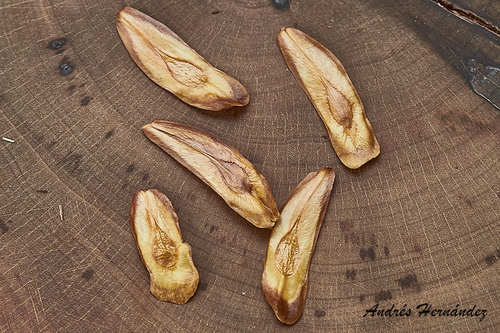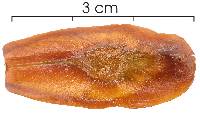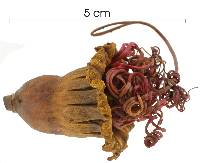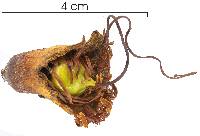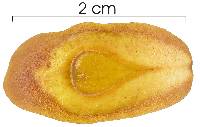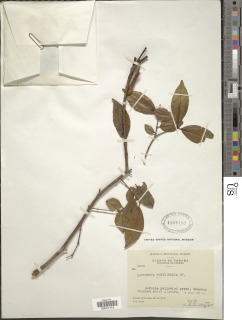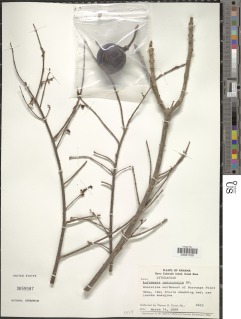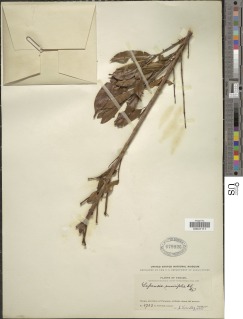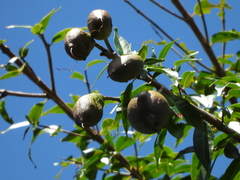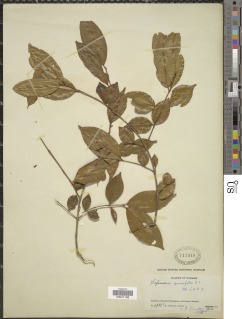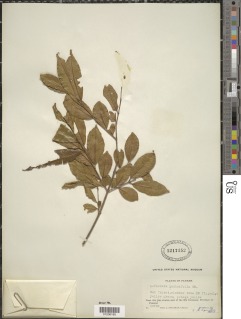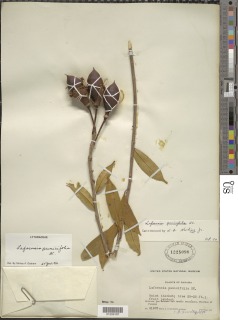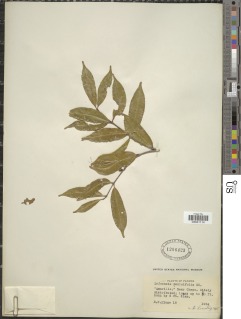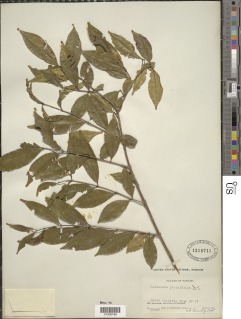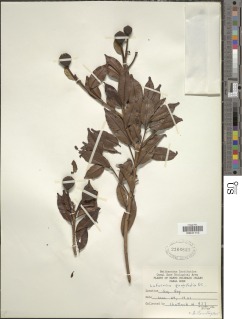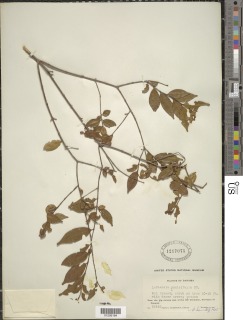

|
|
|
|
Family: Lythraceae
amarillo, more...calabacito
|
Description: A fairly large tree with a straight, cylindrical trunk. Larger trees have small buttresses at the base. The bark is gray, with clear vertical fissures. Leaves are small, opposite, simple, regularly-spaced and in a flat plane. Each leaf has a blunt drip tip at its apex, and underside this tip is a tiny brown cavity (called a domatium). Reproduction: Some leaves turn yellow during the dry season, and some drop but trees are not fully deciduous. Flowers are large, bell-shaped, yellowish or yellow-green, at the ends of the branches, produced from September to December. Fruits are woody capsules, green then brownish-red. The capsule opens during the dry season to release winged seeds. Distribution: A rare tree in the Canal area, with only a handful of individuals known in our plots, all from Barro Colorado to the Pacific coast. Similar Species: Not an easy tree to recognize. The opposite and regularly-spaced leaves look like Myrtaceae, for instance LK eugene Eugenia nesiotica, LK2 but see other species and genera in the family as well. Usually, the Myrtaceae have translucent spots in the leaf. LK mourmy Mouriri myrtilloides LK2 also has similar leaves to Lafoensia, but it lacks petioles. Several Myrtaceae and Mouriri are far more abundant than Lafoensia, making it especially difficult to identify Lafoensia; but note that none of the other species reach large size. Uses: The wood is hard, heavy, fine-quality, and yellowish, and has many uses. Descripción: Árbol de 10 a 30 m de alto. Copa redondeada. Tronco con raíces tablares pequeñas en la base. Corteza exterior gris y fisurada, internamente es amarilla. Ramitas terminales de forma cuadrangular. Hojas simples y opuestas, de 4-10 x 2-4 cm, oblongas o elípticas, con ápice cuspidado, el cual presenta un pequeño poro (domacio) en el envés, bordes enteros y base obtusa. Estípulas pequeñas y deciduas. Pecíolo de 0.3-1 cm de largo y acanalado en la parte superior. Flores amarillas o verde amarillentas, solitarias, ubicadas en los ápices de las ramitas. Frutos en cápsulas leñosas, de 3-5 cm de largo, verdes, tornándose rojizos y dehiscentes al madurar. Semillas aladas. Datos Ecológicos: La especie crece a bajas elevaciones, en bosques secos o húmedos. En Panamá se encuentra en las provincias de Colón, Panamá, Darién y Herrera. Común y fácil de observar en bosques de la parte central del Canal de Panamá. Florece y fructifica entre septiembre y abril. Las flores son visitadas por insectos y murciélagos. Las semillas son dispersadas por el viento. Especies Parecidas: A menudo se confunde con especies del género Eugenia (Myrtaceae), pero en Eugenia las hojas tienen puntos translúcidos y no presentan un pequeño poro en el envés del ápice de la hoja. También se puede confundir con LK mourmy Mouriri myrtilloides LK2 , pero en M. myrtilloides las hojas son sésiles debido a que no tienen pecíolo. Usos: La madera es de color amarillo, dura, pesada, fuerte y de grano fino. Empleada en carpintería y ebanistería, construcciones de pisos, puentes y durmientes de ferrocarril. Del tronco y de las hojas se extrae un colorante de color amarillo. DC., Mém. Soc. Phys. Genève 3(2):86, t. 1. 1828 Glabrous tree, usually 10-15 (27) m tall; trunk to 1 m dbh; outer bark coarse, fissured, brown, thick; inner bark fine, thick, reddish, blending into lemon-yellow wood; sap lacking odor. Leaves deciduous; petioles 4-7 mm long; blades oblong-elliptic, acuminate, obtuse at base, 3-9 cm long, 1-3 cm wide, the acumen often broad at apex, the lower surface with a small pore at apex of midrib. Flowers 12-16-parted, solitary but clustered at apex in leafy pseudoracemes; pedicels 2-3 cm long, stout; bracteoles 2, small, deciduous, at base of flower; hypanthium campanulate, 2-4 cm long, nearly as wide, lobed ca one-third its length, the lobes acuminate; petals yellow or greenish-white, attached ca 5 mm below opening of hypanthium, obovate, 2.5-3 cm long; stamens many, long-exserted; filaments to 9 cm long, becoming reddish, united at base into a fleshy perigynous cup continuous with the ovary; ovary turbinate, ca 1 cm long; style to 10 cm long. Capsules woody, ellipsoid, 4.5-6.5 cm long, brown, pointed at apex; pericarp 3-5 mm thick; seeds numerous, oblong, 2-4 cm long, winged. Croat 7948. Common along the shore; occasional in the forest. Flowers from September to December. The fruits mature in the dry season (January to April). This genus was reported by Nevling in the Flora of Panama (1958) to have indehiscent fruits, but the fruits of L. punicifolia are irregularly dehiscent. After the exocarp of the fruit falls free, the mass of winged seeds are exposed and blow away, usually a layer at a time. Scattered from Mexico to Bolivia. In Panama, reported by Holdridge (1970) from low to middle elevations in moist areas and by Tosi (1971) as a characteristic component of tropical moist forest; known from tropical moist forest on BCI and in Panama and Darién and from premontane moist forest in Panama. |

